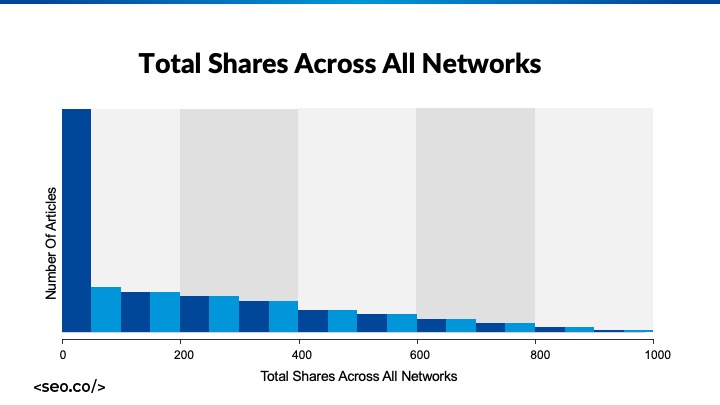How would you like to gain at least 100 readers for your new blog post every day?
How about 200?
There’s really no cap to how many readers your blog could attract on a daily basis, as long as you provide unique, interesting, useful, timely, and relevant content.
But the sad truth is that most blogs receive zero blog traffic and shares:

Despite this example of the Pareto Principle, all indicators point to the notion that blogging continues to gain in popularity and shows no sign of slowing down.
Why? Sure, Facebook-ing and micro-blogging with Twitter are hot, but a lot of people still prefer the meatier stuff that only blogging can deliver.
Blogging has all the benefits that every Internet marketer could ever want:
- One of the greatest platforms for driving or increase blog traffic
- A great tool for sharing useful information
- An unbeatable platform for making opinions known, both by the blogger and his or her audience
- Useful for optimizing content for search engines
- A terrific instrument for gaining and retaining customers
However, it’s not enough just to set up a blog to attract readership. There are best practices and guidelines every blogger should follow for success. Let’s take a look at each important facet of making a blog a worthwhile and profitable endeavor in your greater marketing campaign.
Table of Contents
Preparing Your Blogging Platform
The platform
Choose the best blogging platform for your needs. There are several out there, and they share certain common features, but some are highly preferred and recommended by the most knowledgeable members of the blogging community.
If you are just starting your blog, check out Blogger.com, a blogging platform owned by no less than Google. Blogger.com seems to be a popular choice among newbie bloggers for its ease of use. You can also give Tumblr and WordPress.com a try.
However, if you are looking for some serious blogging features in terms of flexibility and extensibility, WordPress is the top choice. WordPress serves as host to millions of blogs and is the most popular option for most bloggers. It offers a wide range of features and plugins that make a blog powerful, user-friendly, and attractive to search engines.
Choosing the right plugins
This especially applies to blogs hosted in WordPress. WordPress offers bloggers extremely useful and powerful plugins that automate some of the most crucial aspects of blogging.
There are plugins for design and layout. There are plugins for automating internal SEO linking such as popular posts. There are also plugins to integrate your social media efforts into your blogging. And then there are plugins for properly optimizing your blog.
When hunting for the right plugins for your needs, don’t choose on your own. Pick those that come highly recommended by other blogs/bloggers such as the ones suggested here.
Preparing your blog for RSS
RSS is one feature that every newbie blogger should take advantage of for better exposure. That’s because a lot of readers today still check out updates from their favorite blogs through RSS readers, which provides a convenient method for them to track topics under one roof.
Enabling RSS aggregator for your blog helps readers follow it conveniently. Most blogging platforms have a built-in RSS feature. If you are using a blogging platform that does not have this feature built in, however, be sure to instruct readers on how to include your blog into their favorite RSS feed reader.
Preparing Your Blog’s Content
Choosing the subject of your blog
The chances of your succeeding in blogging will depend on the demand for the subject you choose to blog about. Finding a niche about which to blog is crucial if you are to corner a segment of the online crowd.
One way to figure out what people are interested in is to study trending topics via Google Trends. Google Trends lets you “listen in” on certain topics to figure out people’s relative level of interest — based on country, the type of content that drives traffic for a given subject, and even a list of terms that relate to the topic.
There’s also Google Ads Keywords Tool, a tool that allows you to search for long tail keywords with the most number of searches.
But perhaps the best way to start blogging is just to talk about stuff you are highly passionate about or are already an expert on. This provides an easy way for you come up with a list of subtopics that you can feature in the coming days without the trouble of having to do much research on them.
Magnetic topics
Writing about topics that are controversial and very timely, such as the presidential election, seems to guarantee massive readership.
In fact, if you inject your own opinion on certain topics, people of a similar mind will like you. You should also encourage them to interact even more with you by posting their comments and arguing with your views.
Don’t forget that people’s interactions and comments add weight to your blog’s traffic, which allows it to get noticed by the search engines even more.
Click here for a complete list of quality blog title ideas and blog post ideas.
How to Increase Readers to Your Blog (in 10 Steps)
Content marketing is a great way to improve your customer relationships, increase your brand visibility, and earn more conversions from your site visitors. There’s only one problem: in order to get the benefits of your user generated content marketing strategy, you need to have a preliminary readership. Without a first set of eyes to see your content and spread the word, your inbound marketing investment might fizzle.
Your brand’s current customers could serve as a first-line audience, but if you want to scale your visibility and start seeing real results, you’ll need to think bigger. Try using one of these 10 ways to attract new readers to your existing blog:
1. Post on Social Media.
The first step is one of the easiest. Hopefully, if you’ve already got a blogging strategy under your belt, you’ve also got plans for a social media strategy. If not, now’s the time to outline one.
Use popular platforms like Facebook, LinkedIn, Twitter, and Google+ to syndicate links to your most recent posts, and frame or add internal links in a catchy, enticing way. These social platforms are public, giving you access to people all over the world, so post often and engage with others to maximize the initial visibility of your blog.
2. Take Advantage of Guest Posting Opportunities.
Blogging shouldn’t be exclusively refined to your own platform. Look for guest posts opportunities and start taking advantage of them—common places to look include industry-related blogs or forums, or popular publishers who may be looking for content based on your area of expertise. Guest posting on an external blog that already has a steady following will naturally attract more visitors to your own blog, especially if you’re consistent with your offsite efforts. It also has a positive SEO effect if you include a backlink within the body of your content.
3. Invite Guest Posters.
Guest posting isn’t a one-way or traffic strategy. As much as you guest post on external blogs, invite other guest blog posters to publish on yours. It might seem like it takes away from your authority, but on the contrary, having multiple industry experts posting on your blog can do wonders for your authority. Also, those contributors will be likely to post links to that content to their own followers, giving you an influx of new readers for your own blog. This, too, is worth considering as an ongoing strategy.
4. Set Up Pay-Per-Click Ads.
If you’ve got the budget for it, pay-per-click ads are a perfect way to get a new stream of visitors or traffic to your blog. It will cost a bit of money up front, but with PPC management programs, you always get what you pay for: raw blog traffic. By advertising with Google analytics, Bing, or even a social platform like Facebook, you’ll guarantee a stream of new visitors falling within your target demographics. However, you should consider stepping up your conversion optimization efforts to directly recoup some of the costs of PPC advertising.
5. Place Affiliate Links.
Affiliate links are typically reserved for e-commerce sites, but if you’re desperate for some new blog traffic and more blog traffic to your blog post, they’re worth considering. Like with PPC ads, you’ll only be paying for the actual traffic your affiliate links generate, and if you partner with a site you’re familiar with, you could work out a pretty comfortable deal. Since they’re paid links, they won’t contribute to your search engine optimization (SEO) visibility, but they will increase referral traffic.
6. Network With Influencers.
Another strategy is to network directly with major influencers in your industry. Look for personal brands with big followings or individuals who have made a substantial impact in your niche. Reach out to them on social media or in person (when you can), and simply ask if they’d be willing to push out a link to your blog. Even one or two successes could result in hundreds or thousands of fresh eyes on your content.
7. Use Social Bookmarking Sites.
Social sharing and bookmarking sites, like StumbleUpon, Digg, and Reddit, are all valuable places to post your content. It can increase your domain authority, increasing your ranks in Google analytics, but more importantly, it gives your blog the chance to go viral if it catches on.
8. Submit & Syndicate to Content Aggregators.
Submitting to content aggregators is a similar process. Find RSS feeds to submit your blog to, or take some of your best content and submit it to major aggregators of blogs in your industry.
Usually all you have to do is follow a basic submission process or reach out to the webmaster, and as long as your blog fits their niche, you’ll be published in their directory.
We also go over a complete guide to content syndication for SEO in a separate post.
9. Cater to Searchers.
Search visibility is critical for getting new eyes and inbound search traffic for your blog, and a quality link building service is one way to improve your domain authority and ranks. However, it’s also important to write topics that will maximize your chances of getting seen in search engines.
How-to articles, articles that answer specific questions, and articles that cater to common searches are all great choices for topics that will attract searchers to your blog.
How often you blog also matters as search engines like to display new(er) content for readers that can show up higher in search.
10. Find Communities for Your Target Demographics.
Instead of waiting for your users to find you, you can go out and find them. Look for blogs, forums, or any type of online community where your target demographics gather. Then, look for opportunities for you to mention your brand or link to a helpful article in the comments section. Doing so will earn you some new referral more traffic or targeted traffic and increase your domain authority in the process—but make sure what you’re posting is relevant to the conversation and not just a gimmick to lure people to your site. Otherwise, you could be flagged as spam.
If your blog is captivating and informative, your new readers will naturally want to come back to read more. Furthermore, they’ll spread the word, helping to grow the blog on your behalf, and before you know it, you won’t need an outreach strategy at all. In addition to growing your initial audience with these visibility strategies, make sure you retain a focus on the consistency and value of your blog. Doing so through guest blogging through an online content writing service can help you scale things up more rapidly.
The blogging community has yet to reach its saturation point, and there’s much you can do to increase your piece of the action.
If you need help in setting up an SEO blog for your business, let’s talk, and we’ll show you some great strategies that will help you get right in front of your target audience.
Tim holds expertise in building and scaling sales operations, helping companies increase revenue efficiency and drive growth from websites and sales teams.
When he's not working, Tim enjoys playing a few rounds of disc golf, running, and spending time with his wife and family on the beach...preferably in Hawaii.
Over the years he's written for publications like Forbes, Entrepreneur, Marketing Land, Search Engine Journal, ReadWrite and other highly respected online publications. Connect with Tim on Linkedin & Twitter.
- Content Marketing: Using Content & SEO to Grow Your Business [Complete Guide] - October 23, 2024
- SEO for Labor and Employment Lawyers: Top Tactics to Rank - October 4, 2024
- How to Find & Fix Duplicate Content on Your Website - September 24, 2024



